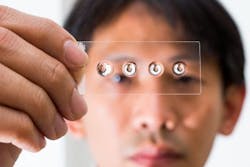Baked-droplet polymer lenses and 3D printing could lead to disposable medical instrumentation
A team of Australian researchers has come up with a way of fabricating good-quality lenses that will cost less than a penny apiece; these "too-cheap-to-meter" lenses are aimed at inexpensive medical microscopy, especially smartphone- and tablet-based remote diagnostic instruments, useful both at home and in the field in developing countries.1 The team includes members from Australia National University (ANU; Canberra), UNSW Australia (Sydney and Darlinghurst), and the Garvan Institute of Medical Research (Darlinghurst).
No lens molds needed
The lenses are made from transparent polydimethylsiloxane (PDMS) elastomer in a simple process. First, a drop (per lens) of PDMS is placed on a microscope slide; it naturally takes a pancake shape and is baked at 70 degrees Celsius to harden it, creating a lens base. Next, another drop of PDMS is placed on each hardened base and the slide turned upside down, causing the drops of PDMS to hand and take a parabolic aspherical shape. After baking again, the lens can be taken off and used as is, or further drops can be added and baked on to fine-tune the lens shape; curvatures down to about 2 mm can be created this way.
"What I'm really excited about is that it opens up lens-fabrication technology," says Steve Lee from the Research School of Engineering at ANU. The lenses can be made cheaply en masse because no grinding and polishing or molding equipment is required—just an oven, a slide, and PDMS.
The researchers created lenses a few millimeters thick with a 160X magnification and a resolution of about 4 μm—2X lower in optical resolution than many commercial microscopes, but more than three orders of magnitude lower in cost. “We're quite surprised at the magnification enhancement using such a simple process," says Lee.
3D-printed microscope for $2
Combining this technique with 3D printing of optical mounts and other hardware can lead to incredibly inexpensive—and even disposable—instrumentation.
In particular, the researchers have built a lens attachment that turns a smartphone camera into a dermascope, which is a tool to diagnose skin diseases like melanoma. While normal dermascopes can cost $500 or more, the phone version costs around $2. The new dermascope, which was made using a 3D printer and is designed for use in rural areas or developing countries, is slated to be commercially available in just a few months, Lee says. A similar smartphone-based tool can also help farmers identify pests out in their fields.
Lee also envisions that the lenses could be used in the lab as implantable lenses that biologists can use to study cells in vivo. The high cost of conventional lenses usually dissuades scientists from implanting them into mice, he says. The lenses would also be useful for hobbyists or as part of low-cost mobile microscopes that could be distributed for educational or outreach purposes.
So far, the researchers can't make lenses much bigger than about 12 mm in diameter. But to expand the range of applications, the team is refining the process to make lenses as large as 50 mm and increase the lens’ optical performance.
REFERENCE:
1. W. M. Lee et al., Biomedical Optics Express (2014); doi: 10.1364/BOE.5.001626
About the Author
John Wallace
Senior Technical Editor (1998-2022)
John Wallace was with Laser Focus World for nearly 25 years, retiring in late June 2022. He obtained a bachelor's degree in mechanical engineering and physics at Rutgers University and a master's in optical engineering at the University of Rochester. Before becoming an editor, John worked as an engineer at RCA, Exxon, Eastman Kodak, and GCA Corporation.

